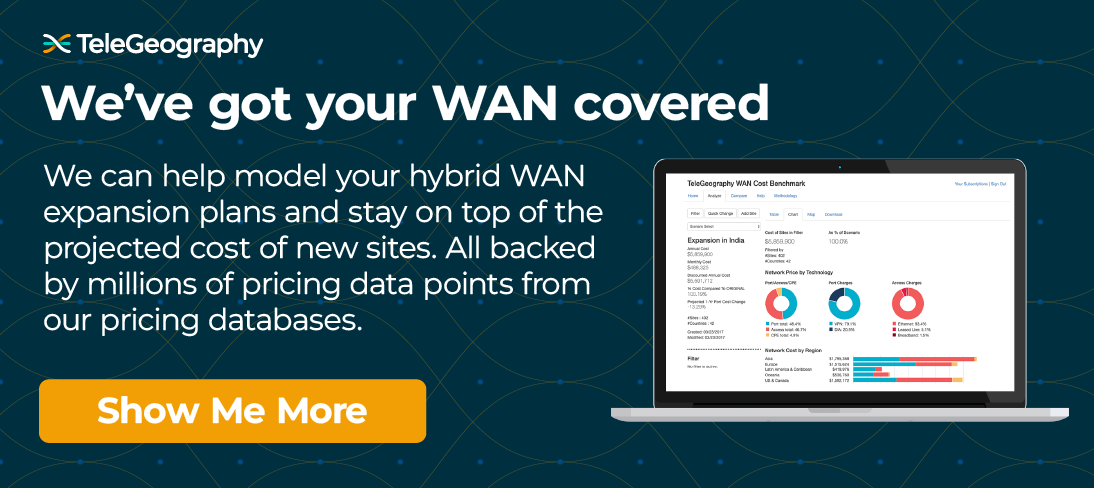"In previous iterations of the WAN, you might have seen one large MPLS cloud, but with core sites having a larger MPLS port than edge sites. Now we're seeing a lot more technology differentiation between core versus middle tier versus edge sites."
A self-proclaimed "data guy," TeleGeography Senior Analyst and Data Science Manager Mike Bisaha has spent years building tools to help IT managers better understand their networks' performance, design, and cost.
And he's learned a lot about the modern WAN in the process.
In this week's podcast, Mike explains best practices for benchmarking a wide-area network against key goals. Who benchmarks? How does this make life easier for a WAN manager? What has benchmarking taught us about networks? And how have the goals of WAN managers shifted over the last five to ten years?
Listen below to learn more.
Start listening every week:
Apple | Google | Stitcher | TuneIn | Podbean | RSS
Key Takeaways
A WAN Cost Benchmark provides an unbiased, third-party cost analysis for corporate WANs.
It helps enterprises and occasionally carriers or vendors understand what they can expect to pay for specific network configurations, including underlay connectivity, equipment like CPE routers, and overlay services such as SD-WAN.
The service leverages TeleGeography's extensive databases to tailor a view specific to a client's network. This allows clients to see anticipated costs component by component and site by site, perform "what if" analysis by experimenting with different technologies and configurations, and visualize cost distribution geographically. Initially, the primary focus was on helping enterprises optimize cost savings during the renewal of three-to-five-year contracts, often with a single supplier for primarily MPLS networks.
Corporate WANs are evolving from predominantly MPLS networks to more complex, hybrid designs.
While MPLS remains central to many networks, there's increasing integration of technologies like DIA and broadband.
SD-WAN is a significant driver for current benchmark clients, often seen as enabling network cost savings. The WAN is increasingly viewed as an asset that enables new applications and technologies, rather than just a cost to be minimized. This leads to more sophisticated network topologies, including tiered designs separating core data centers from middle-tier and edge sites, often using different technologies at each layer (e.g., point-to-point links for core, hybrid DIA/MPLS/Broadband for edge, SD-WAN or IPsec over Broadband for very edge sites). There's also a greater focus on diversity strategies beyond just backup lines, encompassing supplier diversity, fiber route diversity, technology diversity (MPLS, DIA, Broadband), and even multiple CPE vendors at a single site.
A benchmark requires detailed client data. Beyond that, we can do the heavy lifting.
The process starts with the client providing a detailed list of sites by address and an inventory of deployed products, capacities, technologies, and configurations (e.g., MPLS, Broadband, SD-WAN overlay, CPE, backup strategy, core/edge classification).
TeleGeography then geocodes the sites and matches them to their pricing data using algorithms and leveraging their analysts' local market knowledge, especially for challenging "edge case" geographies where data availability is limited.
Greg Bryan
Greg is Senior Manager, Enterprise Research at TeleGeography. He's spent the last decade and a half at TeleGeography developing many of our pricing products and reports about enterprise networks. He is a frequent speaker at conferences about corporate wide area networks and enterprise telecom services. He also hosts our podcast, TeleGeography Explains the Internet.
Mike Bisaha
Michael Bisaha is a Senior Analyst and Director of Data Science at TeleGeography. In addition to his work covering competitive market and pricing trends in the wholesale and enterprise telecom space, he heads the Data Science group responsible for data management, product development, design, forecast modeling, and custom analytics initiatives.






